Tie and dye is an ancient resist dyeing technique where fabric is tied or folded to create unique patterns, with roots in global cultures like India and Japan.
Definition and Overview
Tie and dye is a traditional resist dyeing technique where fabric is folded, tied, or stitched to create resistance areas, preventing dye from penetrating evenly. This method allows for unique, personalized patterns and designs. It involves binding fabric in specific ways to achieve distinctive color distributions. Tie and dye is widely practiced globally, with variations like Bandhani in India and Shibori in Japan. Its artistic charm and versatility make it a popular choice for crafting vibrant, one-of-a-kind textiles. This technique is simple yet creative, offering endless possibilities for experimentation.
Historical Background
Tie and dye techniques trace back thousands of years, with origins in ancient civilizations. Indian Bandhani dates over 5,000 years, while Japanese Shibori has roots in the 8th century. These methods were initially used to create sacred and ceremonial textiles. The technique spread globally, adapting to local cultures and materials. Historical records show tie and dye was used in Africa, Asia, and South America, each region developing unique styles. Over time, it evolved from traditional folk art to a popular craft, influencing modern fashion and design. This rich history underscores its enduring artistic significance.
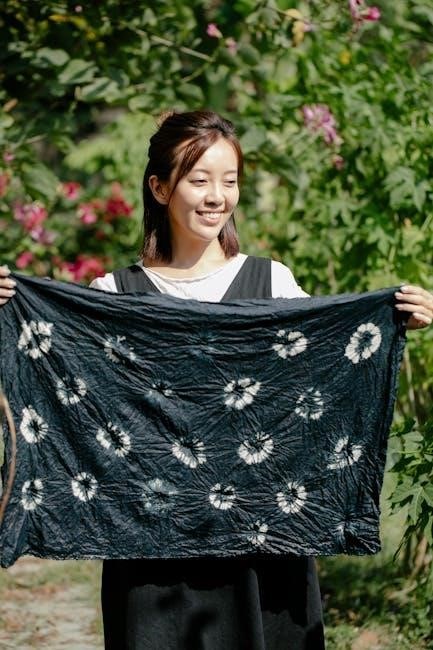
Traditional Tie and Dye Methods
Traditional tie and dye methods include techniques like Indian Bandhani and Japanese Shibori, each with unique tying and knotting styles to create intricate patterns and designs.
Indian Bandhani Technique
The Indian Bandhani technique, a traditional tie and dye method, involves tying small fabric sections into knots before dyeing to create distinctive patterns. Originating over 5,000 years ago, it is deeply rooted in Indian culture, particularly in regions like Rajasthan and Gujarat. Skilled artisans meticulously tie thousands of knots to achieve intricate designs, often symbolizing religious or cultural motifs. The process is time-consuming but results in vibrant, unique textiles cherished for their artistic and historical significance. This method remains a cornerstone of Indian folk art.
Japanese Shibori Method
The Japanese Shibori method, a traditional tie and dye technique, involves intricate folding and binding to create unique patterns. Originating in Japan, Shibori is a form of resist dyeing where fabric is folded, twisted, or pleated and tied tightly before dyeing. This method allows for precise control over the design, resulting in intricate geometric and organic patterns. Shibori is highly valued in Japanese culture for its artistic precision and is often used in high-quality textiles. The technique requires great skill and patience, making each piece truly unique and cherished.

Modern Tie and Dye Techniques
Modern tie and dye techniques blend traditional methods with contemporary tools, offering versatile and creative designs. PDF guides and kits simplify the process for both beginners and experts.
Basic Folding and Tying Methods
Basic folding and tying methods are essential for creating unique tie-dye patterns. Techniques like pleating, twisting, or folding fabric into spirals are common. Tying sections tightly with rubber bands or string prevents dye penetration, forming resist areas. These simple methods allow beginners to achieve vibrant, personalized designs. Proper binding ensures crisp patterns, while loose ties create softer effects. PDF guides often illustrate step-by-step instructions, making it easy to master foundational techniques for various fabric types and projects.
Advanced Patterns and Designs
Advanced tie-dye techniques involve intricate folding, tying, and layering methods to create complex, multi-dimensional patterns. Techniques like shibori knots, pleating, and spiral twisting allow for detailed designs. Experimenting with multiple dye baths and colors can produce rich, layered effects. Some methods incorporate stitching or binding to achieve precise motifs. Advanced designs often blend traditional and modern approaches, offering endless creativity. PDF guides and tutorials provide inspiration for mastering these sophisticated techniques, enabling artists to push the boundaries of tie-dye artistry while maintaining sustainability and eco-friendly practices.

Tools and Materials Required
Essential tools include rubber bands, threads, and dyeing supplies. Natural fabrics like cotton are ideal, while natural dyes enhance sustainability and eco-friendly practices in tie-dye techniques.
Fabric Selection
Choosing the right fabric is crucial for successful tie-dye results. Natural fibers like cotton, linen, and silk are ideal due to their absorbency and breathability. Synthetic fabrics, such as polyester, are less effective as they resist dye absorption. Pre-washing fabric ensures no finish or sizing interferes with dye penetration. Lightweight fabrics allow for easier folding and tying, creating intricate patterns. Always select fabrics suitable for the desired design complexity and dye type. Proper fabric selection enhances the vibrancy and durability of tie-dye designs, making it a foundational step in the process.
Dyes and Binding Materials
Various dyes and binding materials are essential for tie-dye techniques. Natural dyes, such as indigo, turmeric, and pomegranate, offer eco-friendly and sustainable options with earthy tones. Synthetic dyes provide vibrant colors and durability. Binding materials like rubber bands, threads, or stitches are used to resist dye penetration, creating unique patterns. Proper dye selection ensures colorfastness, while binding materials determine the design’s complexity. Choosing the right combination enhances the final result, making dyes and bindings fundamental to achieving desired tie-dye effects. They work together to create resist patterns, ensuring lasting and visually appealing designs.
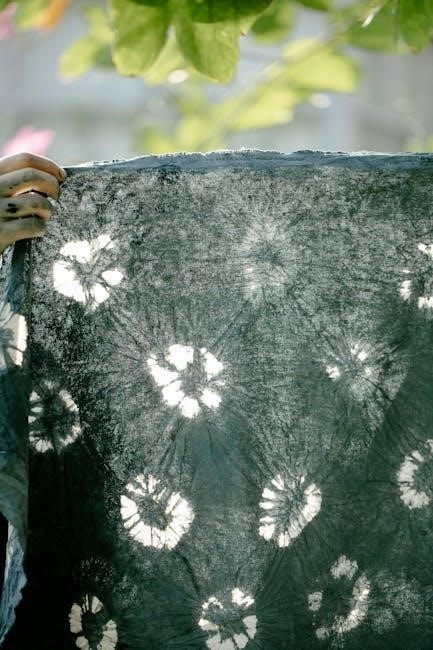
Step-by-Step Process
Prepare fabric, fold or tie to resist dye, immerse in dye, wait, rinse, and set. This method creates unique patterns through resist dyeing techniques.
Preparing the Fabric
Preparing the fabric is crucial for tie and dye. Start by washing natural-fiber fabrics like cotton or linen to remove finishes. Dry thoroughly to ensure better dye absorption. Sketch designs on paper and transfer them to fabric to guide folding or tying. Use a needle and thread to sew patterns or apply rubber bands to create resist areas. Ensure fabric is damp before folding to maintain shape and achieve crisp patterns during dyeing. Proper preparation ensures vibrant colors and desired designs.
Tying and Folding Techniques
Tying and folding are essential in creating patterns for tie-dye. Knotting small fabric sections produces dots or circles, while folding creates stripes or spirals. Twisting fabric into spirals and binding with rubber bands forms unique designs. Stitching patterns before dyeing also creates resist areas. Folding techniques like pleating or accordion folds result in geometric patterns. These methods allow for endless creativity, from simple knots to intricate folds, ensuring each design is personalized and visually striking. Proper tying and folding are key to achieving desired patterns in the final dyed fabric.
Dyeing Process
The dyeing process involves submerging the tied fabric into the dye bath, ensuring even color penetration. Natural or synthetic dyes are used, with colors chosen based on desired patterns. Fabric remains submerged for 10-30 minutes, depending on intensity. After dyeing, rinse gently to remove excess dye without untieing. Washing and drying complete the process. Proper dyeing ensures vibrant, long-lasting colors. Techniques like dipping or spraying can enhance pattern complexity. Fixing agents may be applied to lock colors, preventing fading and ensuring durability of the design.
Washing and Setting the Dye
After dyeing, gently rinse the fabric under cold water to remove excess dye. Untie carefully to avoid color bleeding; Wash separately in mild detergent to set the dye. Hot water can cause colors to fade. Air-drying is recommended to preserve vibrancy. For natural dyes, fixatives like vinegar or salt may be used to enhance colorfastness. Proper washing ensures long-lasting patterns and prevents dye migration. This step is crucial for maintaining the integrity and durability of the tie-dye design, ensuring it remains vibrant for years to come.
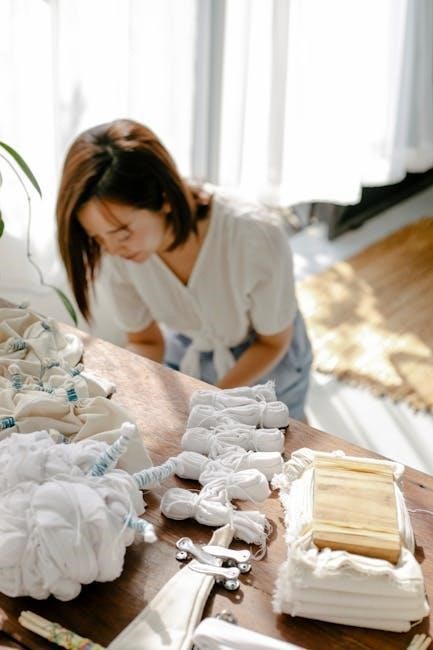
Design Inspiration and Ideas
Tie and dye offers endless creative possibilities, from classic spirals to modern abstract patterns. Experiment with vibrant colors and unique folding techniques to craft distinctive designs. Natural dyes add an eco-friendly touch, while innovative binding methods allow for personalized artistic expressions. Whether aiming for simplicity or complexity, tie and dye encourages exploration and innovation, making it a versatile medium for both traditional and contemporary artistry.
Classic Patterns
Classic tie and dye patterns include timeless designs like spirals, knots, and bullseyes, often created using traditional folding and tying techniques. These designs are deeply rooted in cultural heritage, with methods like Indian Bandhani and Japanese Shibori inspiring intricate, symmetrical motifs. Natural dyes enhance the authenticity of these patterns, which have been passed down through generations. The simplicity and elegance of classic patterns make them universally appealing, allowing artists to create beautiful, enduring designs that celebrate traditional craftsmanship and artistic expression.
- Spirals and knots remain iconic motifs in tie and dye art.
- Traditional techniques ensure timeless beauty and cultural significance.
Modern and Experimental Designs
Modern tie and dye explores innovative techniques, blending traditional methods with contemporary creativity. Designers now experiment with bold colors, multi-layered folding, and unconventional materials, creating unique, abstract patterns. Digital tools inspire new motifs, while eco-friendly practices emphasize sustainability. Synthetic dyes offer vibrant hues, expanding artistic possibilities. Experimental designs often feature asymmetrical shapes and intricate details, pushing the boundaries of this ancient craft. These modern interpretations attract fashion enthusiasts and artists seeking fresh, dynamic expressions in textile art.
- Contemporary designs embrace bold colors and abstract patterns.
- Innovative folding techniques create complex, multi-layered effects.

Natural Dyes and Sustainability
Natural dyes, sourced from plants, herbs, and spices, offer eco-friendly alternatives to synthetic dyes, promoting sustainability in tie and dye practices, reducing environmental impact, and fostering ethical textile production.
Using Natural Dyes
Natural dyes, derived from plants, herbs, and spices, are increasingly popular in tie and dye techniques for their non-toxic and biodegradable properties. These dyes produce vibrant, earthy colors that are unique to each material. Unlike synthetic dyes, natural dyes create a more sustainable and eco-friendly process, reducing environmental harm. However, they may require additional steps like mordanting to ensure colorfastness. Natural dyes not only promote sustainability but also offer a creative way to achieve distinctive patterns, making them a preferred choice for artisans and eco-conscious designers in modern tie and dye practices.
Eco-Friendly Practices
Eco-friendly practices in tie and dye emphasize sustainability by minimizing waste and reducing environmental impact. Techniques include using natural dyes, repurposing fabric scraps, and minimizing water usage. Non-toxic binding materials and energy-efficient drying methods further enhance sustainability. These practices not only promote environmental health but also align with global efforts to reduce chemical pollution in textile production. By embracing eco-conscious methods, artisans and designers can create vibrant, unique designs while contributing to a greener future for fashion and craftsmanship.
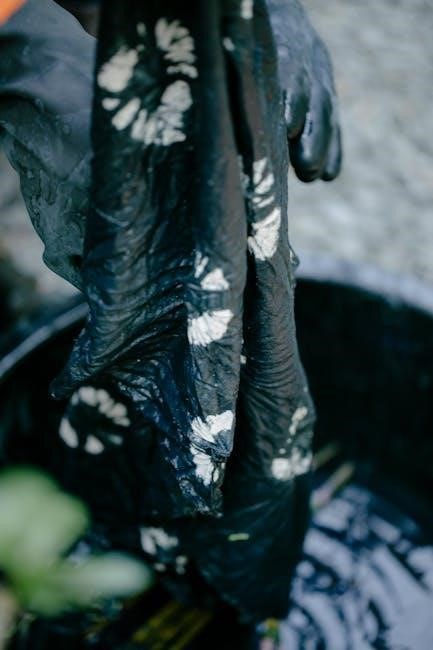
Cultural Significance
Tie and dye holds deep cultural significance, reflecting traditional folk art and community identity. It symbolizes creativity, heritage, and unity across generations and global influences, preserving history through fabric.
Traditional Folk Art
Tie and dye is a cherished traditional folk art, preserving cultural heritage through its unique patterns and methods. Originating in ancient India and Japan, it embodies community identity and artistic expression. Each knot and fold tells a story, passed down through generations. The technique’s simplicity and elegance have made it a symbol of craftsmanship, connecting past and present. Its enduring appeal lies in the blend of tradition and creativity, making it a timeless art form appreciated worldwide.
Global Influence and Adaptation
Tie and dye has transcended cultural boundaries, becoming a global phenomenon. Its adaptation across continents has led to diverse interpretations, blending traditional techniques with modern aesthetics. From African prints to Western fashion, the technique has been reimagined, reflecting local materials and creative visions. This global influence has not only preserved its heritage but also introduced it to new audiences, making it a versatile and enduring art form in contemporary design.

Tie and Dye in Contemporary Fashion
Tie and dye has evolved into a trendy element in modern fashion, with designers incorporating vibrant patterns and sustainable practices into high-end and streetwear collections.
Current Trends
Tie and dye has become a staple in modern fashion, with designers experimenting with bold colors and intricate patterns. The technique is increasingly used in sustainable fashion, emphasizing eco-friendly dyes and organic fabrics. Contemporary designs often blend traditional methods with modern aesthetics, creating unique pieces that appeal to a wide audience. From high-fashion runways to streetwear, tie-dye is celebrated for its versatility and artistic expression. This resurgence highlights a growing appreciation for handmade, personalized clothing, making tie and dye a defining trend in today’s fashion industry.
Designer Applications
High-end fashion designers are embracing tie and dye to create unique, handcrafted pieces that stand out in contemporary collections. By combining traditional techniques with modern twists, designers achieve intricate patterns and vibrant colors that reflect current trends. Many are experimenting with sustainable practices, incorporating natural dyes and organic fabrics. Tie-dye’s versatility allows it to be applied to various textiles, from flowing dresses to luxury accessories. This timeless technique, with its emotional appeal, continues to inspire innovative designs, making it a cornerstone of modern fashion’s artistic expression and cultural relevance.
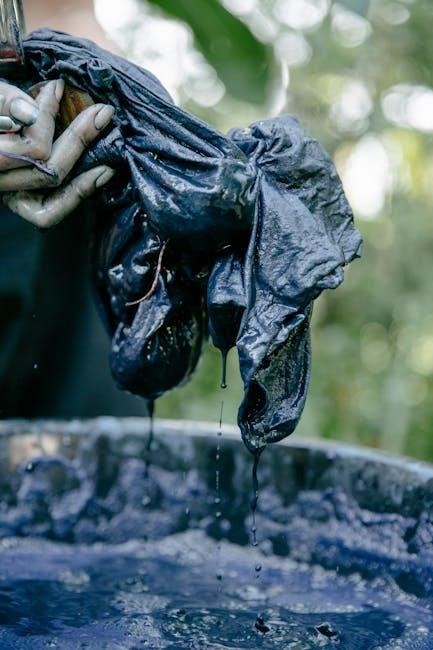
Common Mistakes and Troubleshooting
Common errors include over-tightening fabric, causing uneven dye distribution, and insufficient washing, leading to color bleeding. Proper techniques and post-dye care can prevent these issues;
Identifying Errors
Common mistakes in tie and dye include over-tightening fabric, leading to uneven dye distribution, and insufficient washing, which causes color bleeding. Improper folding techniques can result in unintended patterns. Using low-quality dyes or incorrect binding materials may lead to faded colors or weak resistance. Additionally, not allowing the dye to set long enough can reduce color vibrancy. Recognizing these errors early in the process ensures better outcomes and more consistent results.
To fix errors, loosen overly tight bindings and re-dye if necessary. For color bleeding, rinse gently and reapply dye to affected areas. Adjust folding techniques by re-tying fabric more evenly. Replace low-quality dyes with professional-grade options and ensure proper binding materials are used. Allow sufficient time for dye to set before washing. These corrections enhance pattern clarity and color retention, producing professional-looking results. Regular practice improves technique accuracy and reduces common mistakes in tie and dye projects. Tie and dye is a timeless craft offering endless creativity. From traditional methods to modern innovations, it continues to inspire artists and designers globally, fostering artistic expression and sustainability. Tie and dye is a timeless art form that bridges tradition and modernity, offering endless possibilities for creativity. Its versatility allows for both simple, elegant designs and intricate, experimental patterns. This technique not only preserves cultural heritage but also encourages sustainability through natural dyes and eco-friendly practices. Whether you’re an artist, designer, or hobbyist, tie and dye invites you to explore its boundless potential, fostering innovation while connecting us to our creative roots. Embrace this vibrant craft and unlock new ways to express your unique style and vision; Exploring tie and dye techniques opens a world of creative possibilities. Start with simple folds and knots, then experiment with advanced patterns and natural dyes. Practice on various fabrics to see how textures influence results. Share your creations online or in local craft groups to connect with fellow enthusiasts. As you refine your skills, consider sustainability by using eco-friendly materials. Tie and dye is not just a craft—it’s a journey of self-expression and innovation. Keep experimenting, learning, and pushing the boundaries of this versatile art form to continually grow as a creator.Correcting Techniques
Final Thoughts
Encouragement for Further Exploration